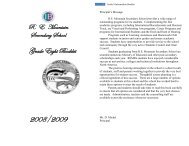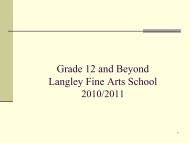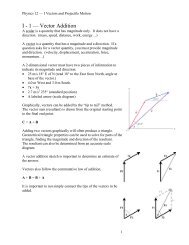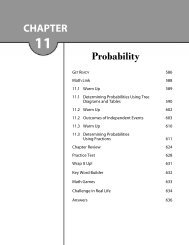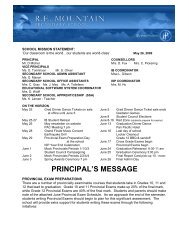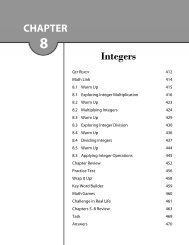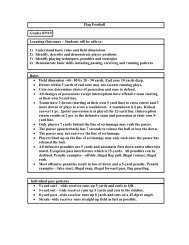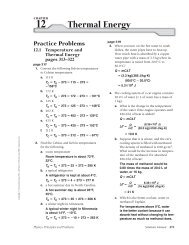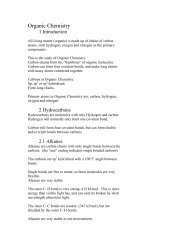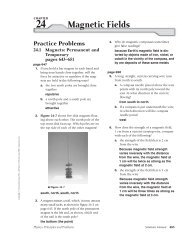Physics Solutions Manual
Physics Solutions Manual
Physics Solutions Manual
You also want an ePaper? Increase the reach of your titles
YUMPU automatically turns print PDFs into web optimized ePapers that Google loves.
Copyright © Glencoe/McGraw-Hill, a division of The McGraw-Hill Companies, Inc.<br />
Chapter 15 continued<br />
receding from the detector for the<br />
Doppler effect to be observed.<br />
Transverse motion produces no<br />
Doppler effect.<br />
Practice Problems<br />
15.2 The <strong>Physics</strong> of Music<br />
pages 411–419<br />
page 416<br />
18. A 440-Hz tuning fork is held above a closed<br />
pipe. Find the spacing between the resonances<br />
when the air temperature is 20°C.<br />
Resonance spacing <br />
so using v<br />
2 f <br />
the resonance spacing is<br />
<br />
2 v 343<br />
m/s<br />
0.39 m<br />
2f<br />
(2)(<br />
440<br />
Hz)<br />
19. A 440-Hz tuning fork is used with a<br />
resonating column to determine the<br />
velocity of sound in helium gas. If the<br />
spacings between resonances are 110 cm,<br />
what is the velocity of sound in helium gas?<br />
Resonance spacing <br />
1.1 m<br />
2<br />
so 2.2 m<br />
v f (2.2 m)(440 Hz) 970 m/s<br />
20. The frequency of a tuning fork is unknown.<br />
A student uses an air column at 27°C and<br />
finds resonances spaced by 20.2 cm. What<br />
is the frequency of the tuning fork? Use the<br />
speed calculated in Example Problem 2 for<br />
the speed of sound in air at 27°C.<br />
v 347 m/s at 27°C<br />
Resonance spacing gives <br />
0.202 m,<br />
2<br />
or 0.404 m<br />
v 347<br />
m/s<br />
f 859 Hz<br />
0.404<br />
m<br />
21. A bugle can be thought of as an open pipe.<br />
If a bugle were straightened out, it would be<br />
2.65-m long.<br />
a. If the speed of sound is 343 m/s, find<br />
the lowest frequency that is resonant for<br />
a bugle (ignoring end corrections).<br />
1 2L (2)(2.65 m) 5.30 m<br />
The lowest frequency is<br />
v<br />
f1 <br />
1<br />
343<br />
m/s<br />
64.7 Hz<br />
5.30<br />
m<br />
b. Find the next two resonant frequencies<br />
for the bugle.<br />
v v 343<br />
m/s<br />
f2 129 Hz<br />
2<br />
L 2.65<br />
m<br />
v 3v<br />
f3 <br />
3<br />
2L<br />
( 3)<br />
( 343<br />
m/s)<br />
194 Hz<br />
( 2)<br />
( 2.65<br />
m)<br />
Section Review<br />
15.2 The <strong>Physics</strong> of Music<br />
pages 411–419<br />
page 419<br />
22. Origins of Sound What is the vibrating<br />
object that produces sounds in each of the<br />
following?<br />
a. a human voice<br />
vocal cords<br />
b. a clarinet<br />
a reed<br />
c. a tuba<br />
the player’s lips<br />
d. a violin<br />
a string<br />
23. Resonance in Air Columns Why is the<br />
tube from which a tuba is made much<br />
longer than that of a cornet?<br />
The longer the tube, the lower the<br />
resonant frequency it will produce.<br />
24. Resonance in Open Tubes How must the<br />
length of an open tube compare to the<br />
wavelength of the sound to produce the<br />
strongest resonance?<br />
The length of the tube should be<br />
one-half the wavelength.<br />
25. Resonance on Strings A violin sounds a<br />
note of F sharp, with a pitch of 370 Hz.<br />
What are the frequencies of the next three<br />
harmonics produced with this note?<br />
A string’s harmonics are whole number<br />
multiples of the fundamental, so the frequencies<br />
are:<br />
<strong>Physics</strong>: Principles and Problems <strong>Solutions</strong> <strong>Manual</strong> 331





